Skip to comments.
The Days of Christmastide -- more than twelve!
CatholicCulture.org ^
| not given
| Catholic Culture.org
Posted on 12/25/2009 9:45:16 PM PST by Salvation


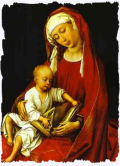 The purest of Virgins gave us our God, who was this day born of her, clothed in the flesh of a Babe, and she was found worthy to feed him at her Breast: let us all adore Christ, who came to save us.
The purest of Virgins gave us our God, who was this day born of her, clothed in the flesh of a Babe, and she was found worthy to feed him at her Breast: let us all adore Christ, who came to save us.
Ye faithful people, let us all rejoice, for our Savior is born in our world: this Day there has been born the Son of the great Mother, and she yet a pure Virgin.
O Queen of the world, and Daughter of a kingly race! Christ has risen from thy womb, as a Bridegroom coming from the bride-chamber: He that rules the stars lies in a Crib. — Antiphon from the ancient Church of Gaul
TOPICS: Apologetics; Catholic; History; Theology
KEYWORDS: catholic; catholiclist; christmas; saints
Navigation: use the links below to view more comments.
first previous 1-20, 21-40, 41-42 next last
To: Tax-chick; SuziQ; rbosque; Bigg Red; Litany
The Sixth Day of Christmastide

 December 30, Sixth Day in the Octave of Christmas
December 30, Sixth Day in the Octave of Christmas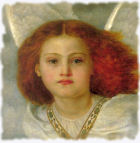 God is your beatitude. The things of time are toys. You are eternity's child and your eternity has already begun! There is a compelling urgency to every day and every hour of the day. In it we are to witness to the truth — that God greeted and gifted us at Christmas.
God is your beatitude. The things of time are toys. You are eternity's child and your eternity has already begun! There is a compelling urgency to every day and every hour of the day. In it we are to witness to the truth — that God greeted and gifted us at Christmas.
If you know what witness means, you understand why God brings St. Stephen, St. John, and the Holy Innocents to the crib in the cave as soon as Christ is born liturgically. To be a witness is to be a martyr. Holy Mother Church wishes us to realize that we were born in baptism to become Christ — He who was the world's outstanding Martyr. — Love Does Such Things, by Rev. M. Raymond, O.C.S.O.
21
posted on
12/30/2009 11:50:37 AM PST
by
Salvation
("With God all things are possible." Matthew 19:26)
To: Salvation
The Seventh Day of Christmastide

 December 31, Seventh Day in the Octave of Christmas
December 31, Seventh Day in the Octave of Christmas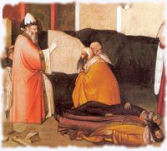 The last day of the year is also the feast of St. Sylvester — bishop of Rome in 314. Constantine gave him the Lateran Palace, which became the cathedral church of Rome. Many legends exist about Sylvester. He supposedly cured Constantine from leprosy and later baptized him on his deathbed.
The last day of the year is also the feast of St. Sylvester — bishop of Rome in 314. Constantine gave him the Lateran Palace, which became the cathedral church of Rome. Many legends exist about Sylvester. He supposedly cured Constantine from leprosy and later baptized him on his deathbed.
New Year's Eve, along with its innocent gaiety, is really a day for serious reflection. On the eve of the civil New Year the children may join their parents in a holy hour, in prayer and thanksgiving for the gifts and benefits which God has given them in the past year, and to pray for necessary graces in the forthcoming civil year.
22
posted on
12/31/2009 4:48:20 PM PST
by
Salvation
("With God all things are possible." Matthew 19:26)
To: Tax-chick; SuziQ; rbosque; Bigg Red; Litany
The Eighth Day of Christmastide

 January 1, Solemnity of Mary, Mother of God
January 1, Solemnity of Mary, Mother of God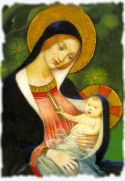 Although New Year's Day is not celebrated by the Church, this day has been observed as a holy day of obligation since early times due to the Solemnity of Mary, Mother of God. Each family and country has different traditional foods to eat on New Year's Day, with lentils being the main superstition: ill luck befalling those who do not eat lentils at the beginning of the year.
Although New Year's Day is not celebrated by the Church, this day has been observed as a holy day of obligation since early times due to the Solemnity of Mary, Mother of God. Each family and country has different traditional foods to eat on New Year's Day, with lentils being the main superstition: ill luck befalling those who do not eat lentils at the beginning of the year.
New Year's is a day of traditional hospitality, visiting and good cheer, mostly with a secular view, but there is no reason that this day, too, could not be sanctified in Christ.
23
posted on
01/01/2010 4:04:18 PM PST
by
Salvation
("With God all things are possible." Matthew 19:26)
To: Salvation
I had a traditional Nap With Baby today. I need to complete the Changing of the Calendars before I go to bed. Someone’s wandered off with my finishing-nails.
24
posted on
01/01/2010 4:31:40 PM PST
by
Tax-chick
(Yo quiero a bailar en Mexico.)
To: Tax-chick; SuziQ; rbosque; Bigg Red; Litany
The Ninth Day of Christmastide

 January 2, St. Basil the Great and St. Gregory Nazianzen
January 2, St. Basil the Great and St. Gregory Nazianzen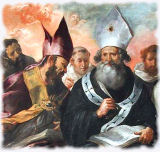 In celebrating the feasts of St. Basil of Caesarea and St. Gregory Nazianzen on the same day, the Church extols a virtue which she has always esteemed, friendship. The friendship between Basil and Gregory was admirable. Born in Cappadocia around 330, they studied together in Athens and then returned to their homeland where they led a monastic life for several years. Their temperaments were very different. While Basil had the qualities of a leader and a gift for organization that made him a legislator for monks in the East, Gregory was a contemplative and a poet.
In celebrating the feasts of St. Basil of Caesarea and St. Gregory Nazianzen on the same day, the Church extols a virtue which she has always esteemed, friendship. The friendship between Basil and Gregory was admirable. Born in Cappadocia around 330, they studied together in Athens and then returned to their homeland where they led a monastic life for several years. Their temperaments were very different. While Basil had the qualities of a leader and a gift for organization that made him a legislator for monks in the East, Gregory was a contemplative and a poet.
The Orthodox Church has placed Basil and Gregory with John Chrysostom in the first rank of ecumenical doctors. They are "the three Hierarchs." — Excerpted from Magnificat, PO Box 91, Spencerville, MD © 2001
25
posted on
01/02/2010 10:21:51 AM PST
by
Salvation
("With God all things are possible." Matthew 19:26)
To: Tax-chick; SuziQ; rbosque; Bigg Red; Litany
The Tenth Day Of Christmastide

 January 3, Solemnity of the Epiphany
January 3, Solemnity of the Epiphany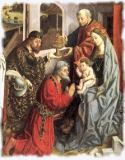 Epiphany is a large celebration, especially in Spanish speaking countries. Things look different around the household: the infant Jesus in the manger now has a small gold crown and is wearing regal robes. The figures of the wise men have reached Bethlehem, completing the nativity scene.
Epiphany is a large celebration, especially in Spanish speaking countries. Things look different around the household: the infant Jesus in the manger now has a small gold crown and is wearing regal robes. The figures of the wise men have reached Bethlehem, completing the nativity scene.
The Church extends itself on Epiphany to the homes of the faithful. The custom of blessing the home on this day probably originated from these words in the Gospel, "And entering into the house, they found the Child with Mary, His Mother, and falling down they adored Him." The priest blesses the house if he can be present, but if not, the father of the family may do so.
26
posted on
01/03/2010 3:08:14 PM PST
by
Salvation
("With God all things are possible." Matthew 19:26)
To: Tax-chick
I’m going to suggest, next year, that we do it in the season of Christmas. They might get more participation, since most families don’t hold school between Christmas and New Year’s Day.Good idea! I'm sure the week between Christmas and New Years must be pretty dull, since everyone crowds caroling in before Christmas.
27
posted on
01/03/2010 7:02:39 PM PST
by
SuziQ
To: Salvation
In New Orleans, Epiphany is the start of Mardi Gras! Between now and midnight on Fat Tuesday, folks will attend parties at which will be served King Cake. The modern iteration of this Twelfth Night Cake is more like a coffee cake, and instead of a bean or pea, the baker hides a plastic Baby Jesus. Whoever get s the Baby Jesus, has to host the next party. ;o)
Before we started our remodel, several years ago, we had a Twelfth Night Party every year, and I always got Mardi Gras decorations, beads, etc. Folks around here don't celebrate it.
Since the living room is piled with packed boxes, we can't have more than 6 or 8 folks over at a time, cause that's all we have room for in our kitchen and den right now. I doubt seriously we'll have it cleaned out by THIS Mardi Gras, and I truly hope that by NEXT Mardi Gras, we'll be living back down in MS, where they know from Mardi Gras!
28
posted on
01/03/2010 7:12:33 PM PST
by
SuziQ
To: SuziQ
I didn’t realize this about the connection with Epiphany and Ash Wednesday — the beginning of Lent. Wow!
29
posted on
01/03/2010 7:15:49 PM PST
by
Salvation
("With God all things are possible." Matthew 19:26)
To: SuziQ
At the nursing homes, I imagine there’s a real let-down after Christmas Day, and the residents would appreciate visitors. My husband has been wanting to do standard Christmas carols in Spanish translation, but we didn’t get much opportunity at church this year, the way the calendar fell. Before next year, I’ll find out where the nursing homes are for Spanish-speaking folks, and we can take our band, and maybe some of the people from our congregation, for singing in the Christmas season, up to Epiphany.
30
posted on
01/03/2010 7:47:36 PM PST
by
Tax-chick
(Yo quiero a bailar en Mexico.)
To: Tax-chick; SuziQ; rbosque; Bigg Red; Litany
The Eleventh Day of Christmastide

 January 4, St. Elizabeth Ann Seton
January 4, St. Elizabeth Ann Seton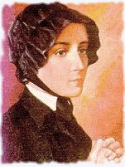 Elizabeth Seton was born on August 28, 1774, of a wealthy and distinguished Episcopalian family. She was baptized in the Episcopal faith and was a faithful adherent of the Episcopal Church until her conversion to Catholicism.
Elizabeth Seton was born on August 28, 1774, of a wealthy and distinguished Episcopalian family. She was baptized in the Episcopal faith and was a faithful adherent of the Episcopal Church until her conversion to Catholicism.
She established her first Catholic school in Baltimore in 1808; in 1809, she established a religious community in Emmitsburg, Maryland. After seeing the expansion of her small community of teaching sisters to New York and as far as St. Loius, she died on January 4, 1821, and was declared a saint by Pope Paul VI on September 14, 1975. She is the first native born American to be canonized a saint.
31
posted on
01/04/2010 4:47:47 PM PST
by
Salvation
("With God all things are possible." Matthew 19:26)
To: Salvation
We have several books about St. Elizabeth Ann: for obvious reasons, she’s very popular at the Seton School, from whom we buy a lot of our curriculum. DP and I tried to go to the Shrine at Emmitsburg once, when we were visiting my parents in D.C., but we got lost and went to Manassas instead.
Nice museum in Manassas, and excellent antique shops for Civil War people.
32
posted on
01/04/2010 5:26:46 PM PST
by
Tax-chick
(Yo quiero a bailar en Mexico.)
To: Tax-chick; SuziQ; rbosque; Bigg Red; Litany
The Twelfth Day of Christmastide

 January 5, St. John Neumann
January 5, St. John Neumann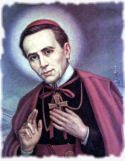 John Neumann was born in Bohemia on March 20, 1811. Since he had a great desire to dedicate himself to the American missions, he came to the United States as a cleric and was ordained in New York in 1836 by Bishop Dubois.
John Neumann was born in Bohemia on March 20, 1811. Since he had a great desire to dedicate himself to the American missions, he came to the United States as a cleric and was ordained in New York in 1836 by Bishop Dubois.
In 1840, John Neumann entered the Congregation of the Most Holy Redeemer (Redemptorists). He labored in Ohio, Pennsylvania and Maryland. In 1852, he was consecrated bishop of Philadelphia. There he worked hard for the establishment of parish schools and for the erection of many parishes for the numerous immigrants. Bishop Neumann died on January 5, 1860; he was beatified in 1963.
33
posted on
01/05/2010 7:03:48 PM PST
by
Salvation
("With God all things are possible." Matthew 19:26)
To: Tax-chick; SuziQ; rbosque; Bigg Red; Litany
The Thirteenth Day of Christmastide

 January 6, Bl. Andre Bessette
January 6, Bl. Andre Bessette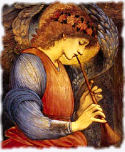 Brother André spent most of his days in a narrow lodge, with only a table, some chairs and a bench as furnishings. He was attentive to the needs of all, smiling, obliging. In the evening he would engage in the difficult work of maintaining the parlor and hallway floors. He was on his knees until late at night, washing, polishing, and waxing by the dim light of a candle. — Abbey of Saint-Joseph de Clairval
Brother André spent most of his days in a narrow lodge, with only a table, some chairs and a bench as furnishings. He was attentive to the needs of all, smiling, obliging. In the evening he would engage in the difficult work of maintaining the parlor and hallway floors. He was on his knees until late at night, washing, polishing, and waxing by the dim light of a candle. — Abbey of Saint-Joseph de Clairval
The use of candles is one of the loveliest Christmas customs that we can keep on using throughout the year. Now, more than ever, Christmas is a festival of light in a dark world, a time to hold our candles high, and to teach our children all the little ceremonies which make life gracious and full of meaning. No matter how long we live, nor how learned we become, we may travel the world over, and find nothing more beautiful than candlelight on the face of a child. "Now the Lord be thanked because we have light." — Dorothy Albaugh Stickell
34
posted on
01/06/2010 3:02:00 PM PST
by
Salvation
("With God all things are possible." Matthew 19:26)
To: Salvation
Making candles is a great idea. We can do some experimentation, and then I can have the homeschool association Middle School Girls over before Easter, maybe.
If we made all these recipes, I’d be HUGH!
35
posted on
01/06/2010 4:00:01 PM PST
by
Tax-chick
(Spend it while you can, money's contraband. You can't take it with you when you go.)
To: Tax-chick
Making candles is fun! I used to save all the good waxy crayons that were all broken up to color them. Some of the crayons now, though, are worthless for this endeavor.
36
posted on
01/07/2010 6:20:35 PM PST
by
Salvation
("With God all things are possible." Matthew 19:26)
To: Tax-chick; SuziQ; rbosque; Bigg Red; Litany
The Fourteenth Day of Christmastide

 January 7, St. Raymond of Penafort
January 7, St. Raymond of Penafort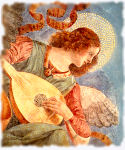 St. Raymond devoted much of his life to helping the poor. The famous incident which is recounted in the story of Raymond's life took place when he went with King James to Majorca. The King dismissed Raymond's request to return home. Relying on his faith and love of God, Raymond walked on the waves to his ship, spread his cloak to make a sail, made the sign of the cross then sailed to the distant harbor of Barcelona.
St. Raymond devoted much of his life to helping the poor. The famous incident which is recounted in the story of Raymond's life took place when he went with King James to Majorca. The King dismissed Raymond's request to return home. Relying on his faith and love of God, Raymond walked on the waves to his ship, spread his cloak to make a sail, made the sign of the cross then sailed to the distant harbor of Barcelona.
For St. Raymond's feast we should remember that, "carolling and story telling belong to the whole Christmas season. Hospitality and giving to others also must continue if true Christmas joy is to remain. An outing to which friends are invited or a party that includes a round of carolling become perhaps even more appropriate with the approach of Epiphany." — Excerpted from The Twelve Days of Christmas
37
posted on
01/07/2010 6:21:14 PM PST
by
Salvation
("With God all things are possible." Matthew 19:26)
To: Salvation
The Cub Scouts made candles with crayons, but they were in chunks, not melted in together.
38
posted on
01/07/2010 7:17:04 PM PST
by
Tax-chick
(Spend it while you can, money's contraband. You can't take it with you when you go.)
To: Tax-chick; SuziQ; rbosque; Bigg Red; Litany
The Fifteenth Day of Christmastide

 January 8, Friday Christmas Weekday
January 8, Friday Christmas Weekday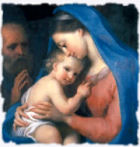 Dawn is the time of day in which the first rays of light begin to glimmer, to illumine and dispel the darkness. . . Christ’s actual birth in Bethlehem shows forth the beautiful reality that God works with things according to their nature. Simply put, it makes perfect sense that a darkened world is tangibly illumined by divine, supernatural intervention upon the natural. — Father Wade L. J. Menezes, CPM
Dawn is the time of day in which the first rays of light begin to glimmer, to illumine and dispel the darkness. . . Christ’s actual birth in Bethlehem shows forth the beautiful reality that God works with things according to their nature. Simply put, it makes perfect sense that a darkened world is tangibly illumined by divine, supernatural intervention upon the natural. — Father Wade L. J. Menezes, CPM
Candles are a symbol of Christ, the Light of the World. The wax is regarded as typifying in a most appropriate way the flesh of Jesus Christ born of a virgin mother. From this has sprung the further conception that the wick symbolizes more particularly the soul of Jesus Christ and the flame the Divinity which absorbs and dominates both. — Catholic Encyclopedia
39
posted on
01/08/2010 6:46:15 PM PST
by
Salvation
("With God all things are possible." Matthew 19:26)
To: Tax-chick; SuziQ; rbosque; Bigg Red; Litany
The Sixteenth Day of Christmastide

 January 9, Saturday Christmas Weekday
January 9, Saturday Christmas Weekday St. Francis initiated the beautiful practice of displaying a Christmas crib or creche. He built it in a cave on a bleak mountain near the village of Greccio. News of what he was doing spread all over the countryside and a steady stream of men, women and chldren came by night carrying torches and candles to light their way.
St. Francis initiated the beautiful practice of displaying a Christmas crib or creche. He built it in a cave on a bleak mountain near the village of Greccio. News of what he was doing spread all over the countryside and a steady stream of men, women and chldren came by night carrying torches and candles to light their way.
"It seemed like midday," wrote someone who was there, "during that midnight filled with gladness for man and beast, and the crowds drawing near, so happy to be present for the renewal of the eternal mystery." Francis himself sang the Gospel story in a voice which was "strong and sweet and clear," says the observer. "Then he preached to the people, most movingly, about the birth of the poor King in little Bethlehem." — Excerpted from Christmas
40
posted on
01/09/2010 3:04:51 PM PST
by
Salvation
("With God all things are possible." Matthew 19:26)
Navigation: use the links below to view more comments.
first previous 1-20, 21-40, 41-42 next last
Disclaimer:
Opinions posted on Free Republic are those of the individual
posters and do not necessarily represent the opinion of Free Republic or its
management. All materials posted herein are protected by copyright law and the
exemption for fair use of copyrighted works.
FreeRepublic.com is powered by software copyright 2000-2008 John Robinson

 The purest of Virgins gave us our God, who was this day born of her, clothed in the flesh of a Babe, and she was found worthy to feed him at her Breast: let us all adore Christ, who came to save us.
The purest of Virgins gave us our God, who was this day born of her, clothed in the flesh of a Babe, and she was found worthy to feed him at her Breast: let us all adore Christ, who came to save us. God is your beatitude. The things of time are toys. You are eternity's child and your eternity has already begun! There is a compelling urgency to every day and every hour of the day. In it we are to witness to the truth — that God greeted and gifted us at Christmas.
God is your beatitude. The things of time are toys. You are eternity's child and your eternity has already begun! There is a compelling urgency to every day and every hour of the day. In it we are to witness to the truth — that God greeted and gifted us at Christmas.  The last day of the year is also the feast of St. Sylvester — bishop of Rome in 314. Constantine gave him the Lateran Palace, which became the cathedral church of Rome. Many legends exist about Sylvester. He supposedly cured Constantine from leprosy and later baptized him on his deathbed.
The last day of the year is also the feast of St. Sylvester — bishop of Rome in 314. Constantine gave him the Lateran Palace, which became the cathedral church of Rome. Many legends exist about Sylvester. He supposedly cured Constantine from leprosy and later baptized him on his deathbed. 
 In celebrating the feasts of St. Basil of Caesarea and St. Gregory Nazianzen on the same day, the Church extols a virtue which she has always esteemed, friendship. The friendship between Basil and Gregory was admirable. Born in Cappadocia around 330, they studied together in Athens and then returned to their homeland where they led a monastic life for several years. Their temperaments were very different. While Basil had the qualities of a leader and a gift for organization that made him a legislator for monks in the East, Gregory was a contemplative and a poet.
In celebrating the feasts of St. Basil of Caesarea and St. Gregory Nazianzen on the same day, the Church extols a virtue which she has always esteemed, friendship. The friendship between Basil and Gregory was admirable. Born in Cappadocia around 330, they studied together in Athens and then returned to their homeland where they led a monastic life for several years. Their temperaments were very different. While Basil had the qualities of a leader and a gift for organization that made him a legislator for monks in the East, Gregory was a contemplative and a poet.  Epiphany is a large celebration, especially in Spanish speaking countries. Things look different around the household: the infant Jesus in the manger now has a small gold crown and is wearing regal robes. The figures of the wise men have reached Bethlehem, completing the nativity scene.
Epiphany is a large celebration, especially in Spanish speaking countries. Things look different around the household: the infant Jesus in the manger now has a small gold crown and is wearing regal robes. The figures of the wise men have reached Bethlehem, completing the nativity scene. 
 John Neumann was born in Bohemia on March 20, 1811. Since he had a great desire to dedicate himself to the American missions, he came to the United States as a cleric and was ordained in New York in 1836 by Bishop Dubois.
John Neumann was born in Bohemia on March 20, 1811. Since he had a great desire to dedicate himself to the American missions, he came to the United States as a cleric and was ordained in New York in 1836 by Bishop Dubois.  Brother André spent most of his days in a narrow lodge, with only a table, some chairs and a bench as furnishings. He was attentive to the needs of all, smiling, obliging. In the evening he would engage in the difficult work of maintaining the parlor and hallway floors. He was on his knees until late at night, washing, polishing, and waxing by the dim light of a candle. — Abbey of Saint-Joseph de Clairval
Brother André spent most of his days in a narrow lodge, with only a table, some chairs and a bench as furnishings. He was attentive to the needs of all, smiling, obliging. In the evening he would engage in the difficult work of maintaining the parlor and hallway floors. He was on his knees until late at night, washing, polishing, and waxing by the dim light of a candle. — Abbey of Saint-Joseph de Clairval St. Raymond devoted much of his life to helping the poor. The famous incident which is recounted in the story of Raymond's life took place when he went with King James to Majorca. The King dismissed Raymond's request to return home. Relying on his faith and love of God, Raymond walked on the waves to his ship, spread his cloak to make a sail, made the sign of the cross then sailed to the distant harbor of Barcelona.
St. Raymond devoted much of his life to helping the poor. The famous incident which is recounted in the story of Raymond's life took place when he went with King James to Majorca. The King dismissed Raymond's request to return home. Relying on his faith and love of God, Raymond walked on the waves to his ship, spread his cloak to make a sail, made the sign of the cross then sailed to the distant harbor of Barcelona.  Dawn is the time of day in which the first rays of light begin to glimmer, to illumine and dispel the darkness. . . Christ’s actual birth in Bethlehem shows forth the beautiful reality that God works with things according to their nature. Simply put, it makes perfect sense that a darkened world is tangibly illumined by divine, supernatural intervention upon the natural. — Father Wade L. J. Menezes, CPM
Dawn is the time of day in which the first rays of light begin to glimmer, to illumine and dispel the darkness. . . Christ’s actual birth in Bethlehem shows forth the beautiful reality that God works with things according to their nature. Simply put, it makes perfect sense that a darkened world is tangibly illumined by divine, supernatural intervention upon the natural. — Father Wade L. J. Menezes, CPM